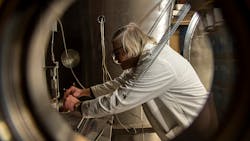Most space-bound rockets end up as space junk. To bring those rockets back to Earth, engineers at Purdue University developed a “drag sail” capable of pulling a rocket out of orbit and safely returning it to Earth. The drag sail will be tested on board a Firefly Aerospace rocket expected to launch in November from Vandenberg Air Force Base, CA. It will be launched on the rocket as part of the Dedicated Research and Education Acceleration Mission (DREAM) along with six other payloads. This will be the first flight for the privately held Firefly Aerospace.
“High-value orbits around Earth are getting congested,” said David Spencer, a Purdue adjunct associate professor of aeronautics and astronautics and the mission manager for the Mars Sample Return Campaign at NASA’s Jet Propulsion Laboratory (JPL). “If we don’t get satellites or other launch vehicle components out of orbit, then eventually highly utilized orbits are going to become unusable for other space systems,” he said. “Drag sail technology is designed to launch with a host spacecraft or launch vehicle and deploy at the end of the host vehicle’s mission. The drag provided by the Earth’s atmosphere will accelerate the vehicle’s deorbit.”
The drag sail, called “Spinnaker 3,” is named after its 3-m-long booms. It is not the first drag sail to be launched into space, but it is the first to be large enough to deorbit the upper stage of a launch vehicle. The Alpha rocket launch for Firefly Aerospace is being planned for an orbiting altitude of about 200 miles. The Spinnaker3 drag sail is capable of deorbiting rockets and launch vehicles at altitudes of 400 miles or more above the Earth. Spinnaker3 (see the figure) employs 3-m-long carbon fiber booms that pull out a sail with an area of 194 ft.2 The sail employs a fluorinated polyimide material called CP-1, produced by the company NeXolve Materials and designed to withstand any deterioration effects of monatomic oxygen in low Earth orbit.
Purdue spacecraft laboratory engineer Anthony Cofer (see the figure) who led the design and testing of the drag sail assembly explains: “This drag sail has booms like a sailboat does but sailing through space is quite different. The drag sail booms need to be extremely lightweight, and they need to be stowed into a tight volume.” Cofer added: “Once deployed, the sail needs to maintain its integrity throughout the deorbit phase, which could be months or years.” Launch vehicles have traditionally been deorbited by means of propellants which, by inclusion, can greatly limit the vehicle’s payload mass. Drag sails use atmospheric drag to slow the vehicle and save payload space in the process.
About the Author
Jack Browne
Technical Contributor
Jack Browne, Technical Contributor, has worked in technical publishing for over 30 years. He managed the content and production of three technical journals while at the American Institute of Physics, including Medical Physics and the Journal of Vacuum Science & Technology. He has been a Publisher and Editor for Penton Media, started the firm’s Wireless Symposium & Exhibition trade show in 1993, and currently serves as Technical Contributor for that company's Microwaves & RF magazine. Browne, who holds a BS in Mathematics from City College of New York and BA degrees in English and Philosophy from Fordham University, is a member of the IEEE.
